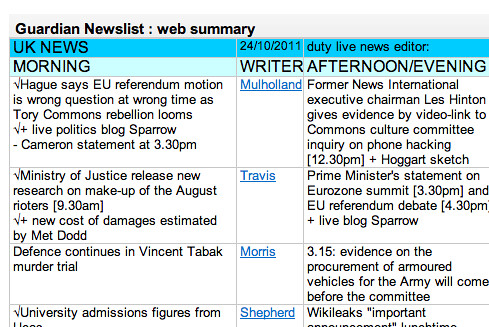 This month the Guardian has started a fascinating experiment whereby every single day it will release a Google Doc of the stories its journalists are writing. The aim is to encourage readers to get in touch if they have something to add or if they want to make a comment for inclusion.
This month the Guardian has started a fascinating experiment whereby every single day it will release a Google Doc of the stories its journalists are writing. The aim is to encourage readers to get in touch if they have something to add or if they want to make a comment for inclusion.
Think forward features lists for the digital age!
In the increasingly real-time, news-fuelled world in which we live, the old practice of drawing up feature synopses months in advance doesn’t really hold sway and many publications are largely ignoring the practice.
So when it comes to journalist relations, most PR professionals will be getting in touch with journalists directly to catch up on what they are writing, following them on Twitter to identify areas in which they show interest and, of course, proactively suggesting ideas for topical articles and opinion pieces.
This move by the Guardian just takes things that one step further, as the introductory post states:
“You can tell us what you think of individual stories and suggest lines of inquiry using Twitter by tweeting to the hashtag #opennews. We will retweet a selection in the panel of our tweets opposite. Alternatively, try contacting whichever reporter has been assigned to the story by clicking on the link next to their name and sending them a Twitter message.”
As a side note, it is interesting that Twitter is the chosen communication channel rather than email – something that we are increasingly noting with many of our journalist contacts.
So what does this mean for PR?
I think this is a massively positive step and echoes the ‘democratisation of the media’ trend that has existed since the beginnings of the social web. Social technologies allow journalists to communicate with PRs, readers and experts in new ways both to source stories and supporting comments.
It’ll be interesting to see whether other publishers start to follow suit.

